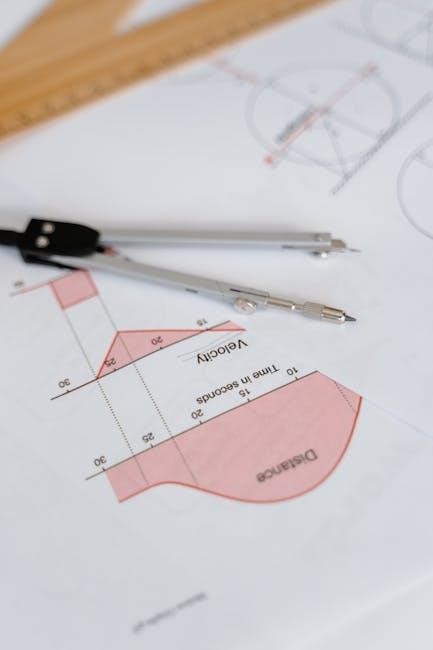Unit 7 Test Study Guide: Right Triangles and Trigonometry

This comprehensive guide covers essential concepts like the Pythagorean Theorem, special right triangles (45-45-90 and 30-60-90), trigonometric ratios (sine, cosine, tangent), and real-world applications. Mastering these topics is crucial for solving problems in geometry and related fields.
A right triangle is a triangle that contains one 90-degree angle, with the other two angles summing to 90 degrees. This fundamental shape in geometry is characterized by its three sides: two legs (the sides forming the right angle) and a hypotenuse (the side opposite the right angle and the longest side of the triangle). Right triangles are essential in various fields, including construction, physics, and engineering, as they often represent real-world scenarios involving heights, distances, and slopes.
Understanding right triangles is the cornerstone of trigonometry, as they allow us to define basic trigonometric ratios and solve for unknown sides and angles. Key concepts include identifying the legs and hypotenuse, calculating side lengths using the Pythagorean Theorem, and understanding the relationships between angles and sides. Mastery of these basics is critical for progressing in geometry and trigonometry.
Common applications of right triangles include determining the height of objects, calculating distances, and solving word problems involving right-angled scenarios. Practicing with various examples will help solidify your understanding and prepare you for more complex topics in this unit.
The Pythagorean Theorem
The Pythagorean Theorem is a fundamental principle in geometry that relates the sides of a right triangle. It states that for any right triangle, the square of the hypotenuse (c) is equal to the sum of the squares of the other two sides (a and b): a² + b² = c². This theorem allows you to find the length of an unknown side when the other two sides are known.

To solve for an unknown side, rearrange the formula depending on which side you need to find. For example, if solving for a leg (a or b), use a = √(c² ー b²) or b = √(c² ー a²). If solving for the hypotenuse (c), use c = √(a² + b²). Always round your answer to the nearest tenth for practical applications.
Understanding and applying the Pythagorean Theorem is essential for solving problems in geometry, trigonometry, and real-world scenarios, such as determining distances or heights in construction or physics. Regular practice with various problems will help reinforce this concept and improve your problem-solving skills.
Converse of the Pythagorean Theorem
The Converse of the Pythagorean Theorem is a complementary principle that helps classify triangles based on their side lengths. It states that if the sum of the squares of two sides of a triangle equals the square of the third side, then the triangle is a right triangle. Mathematically, for sides a, b, and c (with c being the longest), if a² + b² = c², the triangle is right-angled.
This theorem is particularly useful for determining the type of triangle when the sides are known but no angles are provided. For instance, if a² + b² > c², the triangle is acute, and if a² + b² < c², it is obtuse. Understanding this concept enhances your ability to classify and analyze triangles effectively, which is crucial in various geometric and real-world applications.
Practicing problems that involve applying the converse will help solidify your understanding of triangle classification and prepare you for more advanced topics in trigonometry and geometry.
Special Right Triangles

Special right triangles are standardized triangles with known side ratios, making calculations more straightforward. The two most common types are the 45-45-90 and 30-60-90 triangles. In a 45-45-90 triangle, the legs are equal, and the hypotenuse is leg × √2. For example, if each leg is 5 units, the hypotenuse is 5√2. This triangle is often seen in isosceles right triangles, such as the diagonal of a square.
A 30-60-90 triangle has side ratios of 1 : √3 : 2, where the sides opposite the 30°, 60°, and 90° angles are 1, √3, and 2, respectively. For instance, if the shortest side is 4 units, the hypotenuse is 8 units, and the longer leg is 4√3. These triangles frequently appear in real-world applications, such as determining heights or distances in construction or physics.
Mastery of these special triangles simplifies problem-solving in geometry and trigonometry, reducing the need for complex calculations. Memorizing their side ratios is essential for efficiently solving problems.
45-45-90 Triangles
A 45-45-90 triangle is an isosceles right triangle with two equal angles of 45° and one right angle of 90°. The side lengths follow a specific ratio: the legs are equal, and the hypotenuse is leg × √2. For example, if each leg measures 7 units, the hypotenuse is 7√2 units. This triangle is commonly found in real-world applications, such as in square diagonals or isosceles right triangles.
Key properties include:
- The legs are congruent.
- The hypotenuse is √2 times longer than each leg.
- Trigonometric ratios for 45° include sin(45°) = cos(45°) = √2/2 and tan(45°) = 1.
Understanding 45-45-90 triangles simplifies calculations in geometry and trigonometry, especially in problems involving symmetry or equal proportions. Practice solving for unknown sides and angles to master this concept.
30-60-90 Triangles
A 30-60-90 triangle is a special right triangle with angles measuring 30°, 60°, and 90°. The side lengths follow a specific ratio: 1 : √3 : 2, where the side opposite the 30° angle is the shortest (1 unit), the side opposite the 60° angle is √3 units, and the hypotenuse is 2 units. This ratio is crucial for solving problems involving these triangles.
Key properties include:
- The side opposite the 30° angle is the shortest and often denoted as 1 unit.
- The side opposite the 60° angle is √3 times longer than the shortest side.
- The hypotenuse is twice the length of the shortest side.
- Trigonometric ratios for 30° and 60° are essential:
sin(30°) = 1/2, cos(30°) = √3/2, tan(30°) = 1/√3,
sin(60°) = √3/2, cos(60°) = 1/2, and tan(60°) = √3.
Mastering 30-60-90 triangles is vital for solving various geometry and trigonometry problems, especially those involving precise angle measurements and side ratios. Practice identifying and applying these ratios to ensure proficiency.
Pythagorean Triples

Pythagorean triples are sets of three positive integers (a, b, c) that satisfy the Pythagorean Theorem, where a² + b² = c². These triples represent the side lengths of right triangles. Common examples include (3, 4, 5), (5, 12, 13), and (7, 24, 25). These triples are useful for quickly identifying right triangles and calculating side lengths without complex computations.

Understanding Pythagorean triples helps in solving problems involving right triangles efficiently. They also illustrate how integer ratios can form perfect right triangles. For example, in a (3, 4, 5) triangle, 3 and 4 are the legs, and 5 is the hypotenuse. These triples are fundamental in geometry and trigonometry, aiding in real-world applications like construction and engineering. While they simplify problem-solving, not all right triangles have integer sides, so the Pythagorean Theorem remains essential for non-integer cases.
Memorizing common triples and practicing their application is crucial for mastering right triangle problems. This knowledge also supports understanding special right triangles and trigonometric ratios. Pythagorean triples are a cornerstone of geometry, enabling quick and accurate solutions in various mathematical and practical scenarios.
Trigonometric Ratios
Trigonometric ratios are fundamental in understanding right triangles and their applications. They relate the angles of a triangle to the ratios of its sides. The primary ratios are sine (sin), cosine (cos), and tangent (tan), each defined based on the opposite, adjacent, and hypotenuse sides relative to a given angle.
Sine of an angle is the ratio of the opposite side to the hypotenuse, cosine is the ratio of the adjacent side to the hypotenuse, and tangent is the ratio of the opposite side to the adjacent side. These ratios are essential for solving triangles, determining missing sides or angles, and applying trigonometric principles in real-world scenarios.
Mastering these ratios is crucial for progressing in trigonometry and related fields like physics and engineering. Understanding how to apply them in various problems enhances problem-solving skills and prepares students for more advanced mathematical concepts.
Sine, Cosine, and Tangent
Sine, cosine, and tangent are the primary trigonometric ratios used to describe the relationships between the angles and sides of right triangles. These ratios are essential for solving problems involving angles, sides, and their applications in various fields.
Sine (sin) of an angle is defined as the ratio of the length of the opposite side to the hypotenuse. Cosine (cos) is the ratio of the adjacent side to the hypotenuse. Tangent (tan) is the ratio of the opposite side to the adjacent side. Understanding these definitions allows students to determine missing sides or angles in right triangles.
Key points to remember include:
- Using the ratios to solve for unknown sides or angles.
- Applying these ratios in real-world problems, such as determining heights or distances.
- Recognizing the relationships between the ratios (e.g., tan = sin/cos).
Mastering sine, cosine, and tangent is foundational for advanced trigonometric concepts and their practical applications in fields like physics, engineering, and navigation.
Inverse Trigonometric Functions
Inverse trigonometric functions are essential for finding the measure of an angle when the lengths of the sides of a right triangle are known. These functions include arcsin (sin⁻¹), arccos (cos⁻¹), and arctan (tan⁻¹). They are used to “reverse” the sine, cosine, and tangent ratios, respectively.
For example, if the ratio of the opposite side to the hypotenuse (sine) is known, arcsin can be used to find the corresponding angle. Similarly, arccos and arctan are used to find angles when the adjacent side-to-hypotenuse and opposite side-to-adjacent side ratios are known, respectively.
Key points to remember:
- Use inverse functions to solve for angles in real-world problems.
- Understand the domain and range of each inverse function.
- Practice using calculators to find inverse trigonometric values accurately.

Mastering inverse trigonometric functions is crucial for advanced problem-solving in trigonometry and its applications in engineering, physics, and navigation.
Angles of Elevation and Depression

Angles of elevation and depression are critical concepts in trigonometry, often used to describe the orientation of lines relative to the horizontal. An angle of elevation is measured from the horizontal upward to an object, while an angle of depression is measured from the horizontal downward to an object. Both angles are equal in measure but differ in direction.
These angles are commonly used in real-world applications such as surveying, engineering, and physics. For example, determining the height of a building or the slope of a road often involves calculating angles of elevation or depression.
To solve problems involving these angles, use trigonometric ratios (sine, cosine, tangent) and the properties of right triangles. Practice drawing diagrams to visualize the scenarios and label the horizontal line, angle, and vertical or sloped lines appropriately.
Key skills to master include identifying the angle of elevation or depression, setting up trigonometric equations, and interpreting results in context. Understanding these concepts will enhance your ability to solve practical problems effectively.
Real-World Applications of Right Triangles
Right triangles are fundamental in various real-world applications, making them essential for problem-solving in multiple fields. In construction, right triangles are used to ensure buildings are square and level, while the Pythagorean Theorem helps calculate distances and heights for blueprints and frameworks. Carpenters rely on these principles to install roofs, stairs, and other structures accurately.
In physics and engineering, right triangles are used to resolve vectors into horizontal and vertical components, which is critical for calculating forces and motion. Navigation systems, such as those used by pilots and sailors, depend on right triangles to determine distances and directions, ensuring safe and efficient travel.
Landscapers and surveyors use right triangles to measure slopes and gradients, ensuring proper drainage and terrain alignment. Even in everyday activities, such as hanging pictures or laying flooring, understanding right triangles helps achieve precise measurements. These practical applications highlight the importance of mastering right triangle concepts for real-world problem-solving.
Real-World Applications of Trigonometry
Trigonometry plays a vital role in numerous real-world applications, making it a cornerstone of STEM fields. In physics, trigonometric ratios are used to analyze wave patterns, such as sound and light waves, and to calculate forces in complex systems. Engineers rely on trigonometry to design structures like bridges and buildings, ensuring stability and safety.
Astronomers use trigonometric functions to determine the distances and positions of celestial objects, such as stars and planets. GPS technology also depends on trigonometry to pinpoint locations and calculate routes efficiently. In navigation, pilots and sailors use trigonometric principles to chart courses and determine distances between landmarks.
In biology, trigonometry helps analyze growth patterns and population distributions. Medical imaging techniques, like MRI and CT scans, use trigonometric algorithms to create detailed body images. Even in everyday life, trigonometry is used in music, photography, and video games to create realistic effects and simulations.
Understanding trigonometry is essential for solving real-world problems and advancing in various careers. These practical applications emphasize the importance of mastering trigonometric concepts for future success in science, technology, engineering, and mathematics.
Review and Practice Problems
To ensure mastery of right triangles and trigonometry, this section provides a comprehensive review of key concepts through practice problems. Students can test their understanding by solving problems involving the Pythagorean Theorem, special right triangles, and trigonometric ratios. Practice problems range from basic calculations to complex word problems, simulating real-world scenarios.
Review questions focus on identifying legs, hypotenuses, and angles in right triangles, as well as applying inverse trigonometric functions. Mixed-topic problems integrate multiple concepts, such as using sine, cosine, or tangent to solve for unknowns. Additionally, there are sections dedicated to Pythagorean triples and their applications.
Practice problems are categorized by difficulty, allowing students to gradually build confidence. Detailed solutions and explanations are provided for each problem, helping learners identify and correct mistakes. This section emphasizes problem-solving strategies and time management techniques to prepare students for the unit test.
Regular practice with these problems ensures a solid foundation in right triangles and trigonometry, making it easier to tackle advanced topics and real-world applications. Utilize this section to reinforce learning and achieve success on the test.
Test-Taking Strategies
Effective test-taking strategies are essential for success on the Unit 7 test. Start by thoroughly reviewing the study guide and practicing all types of problems. Understand the test format and time limits to manage your time wisely during the exam.
Skim the entire test first to identify easier problems and tackle them early to build confidence. For each question, read it carefully, identify the key concepts involved, and plan your approach. Show all your work, as partial credit may be awarded for correct steps.
If you encounter a difficult problem, don’t spend too much time on it—move on and return later. Use estimation to check if your answers make sense. Always verify your calculations and logic before finalizing your responses.
Stay calm and focused throughout the test. Avoid guessing unless you can eliminate incorrect options. Use the strategies you’ve learned, such as the Pythagorean Theorem or trigonometric ratios, systematically.
Finally, review your answers before submitting the test. This helps catch errors and ensures you’ve addressed all parts of each question. By combining solid preparation with smart test-taking tactics, you’ll be well-prepared for success.
Final Tips for Success
To achieve success in Unit 7, stay organized and proactive. Begin by creating a detailed study schedule, ensuring ample time for each topic, such as the Pythagorean Theorem, special right triangles, and trigonometric ratios.
Use active learning techniques like solving practice problems, watching video tutorials, and teaching concepts to a partner. Flashcards are also effective for memorizing key formulas and definitions. Regular review helps reinforce understanding and reduces exam stress.
Simulate test conditions by timing yourself during practice sessions. This builds time management skills and familiarizes you with the pressure of a real test. Additionally, seek support from teachers or classmates if specific concepts are challenging.
On the day of the test, arrive early, well-rested, and with all necessary materials. Stay hydrated and maintain a positive mindset. Remember, confidence comes from thorough preparation. Best of luck on your Unit 7 test!



